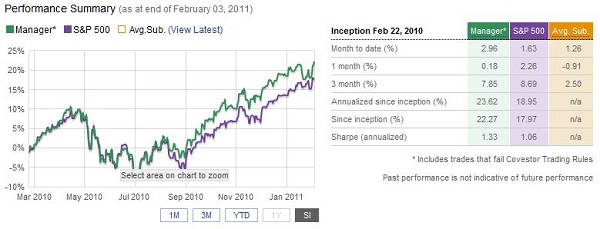Author: John Ballard
Covestor model: Mid-cap Fundamentals
Disclosure: Long NFLX, AMZN, ATVI
My goal is to find the companies with the best prospects for long term growth and buy them. The reason why this model is titled a mid-cap model is because I find that typically the best long term growth stories are those companies with a market value less than $10 billion. However, I am not shy to occasionally invest in a solid large cap stock if I feel it is undervalued.
I manage large caps differently than the smaller companies in the model. I buy moderately growing large caps, like Wal-Mart (WMT) for example, at an undervalued price and sell the stock when it reaches a more appropriate valuation.
With small caps and mid caps, as long as the growth story is still intact, I don’t sell just because the valuation looks a little high, or even too high. Actually, I’m willing to keep adding to small/medium sized companies like Netflix (NFLX) at higher and higher prices. There is a valuation limit where I’ll back off adding to a stock like Netflix; I am a value-conscious investor, after all. But companies like Netflix have such a long runway of growth that the “fair value” for a stock like that is way beyond what most investors realize. Most investors have a tendency to underestimate the growth potential of a high growth company. I’m not exactly sure why that is, but they do. I have committed the same mistake; it’s just human nature.
We have quite a few holdings that are technically large caps but, because of their high growth prospects, I want them in the model. Now, if I buy an Activision (ATVI) or Netflix (which we own) and it becomes a large cap, I don’t start selling it. The catalyst to sell a growth company that I originally bought as a mid-cap will be dependent exclusively on the future return I expect out of the stock relative to other growth opportunities available.
I decided to add to our Netflix holding after the company reported another blockbuster quarter. I am not shy to buy Netflix after it pops 10 or 20 percent. When a high growth stock pops like that after a great quarter of growth, it usually tells me that the market is struggling to discount all the expected future growth of the stock. It goes back to my view that most investors underestimate a wonderful company’s growth potential over the long term.
Netflix is in the process of transitioning to a more international business, which is a huge growth opportunity when it hasn’t even reached its potential here domestically. Plus, I don’t believe the market really understands what makes Netflix such a great business. They are providing great content and a great service to millions of subscribers (including myself) for a cheap price – just $7.99 per month – that beats the pants off of anything satellite or cable can match. Netflix is one of the great growth stories of our time.
A good example of a large cap that we own and in which I plan to steadily keep buying is Amazon (AMZN). Amazon is misunderstood, similarly to Netflix, by a lot of Wall Street analysts. Amazon announced a good solid quarter, once again, last week, and analysts were worried about the dip in margin. This presents a great opportunity to buy another incremental position as analysts focus on margins when management is focused on elements like return on invested capital and growing free cash flow per share. These are the metrics that will ultimately determine the future intrinsic value for any business. Based on expected growth over the next 10 years and beyond, I believe Amazon is still undervalued. I have no doubt Amazon will have a larger market value than Wal-Mart someday.



